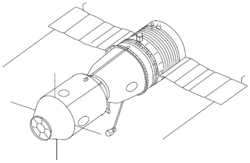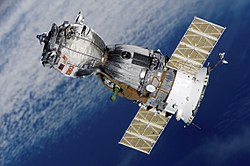 | |
| Manufacturer | OKB-1 |
|---|---|
| Country of origin | Soviet Union |
| Applications | Carry up to three cosmonauts to lunar orbit. |
| Specifications | |
| Regime | Low Earth Medium Earth Circumlunar |
| Production | |
| Status | Cancelled |
| Launched | None |
| Related spacecraft | |
| Derivatives | Soyuz 7K-OK (first Soyuz generation to fly crewed) |
Sergei Korolev initially promoted the Soyuz A-B-V circumlunar complex (7K-9K-11K) concept (also known as L1) in which a two-man craft Soyuz 7K would rendezvous with other components (9K and 11K) in Earth orbit to assemble a lunar excursion vehicle, the components being delivered by the proven R-7 rocket. [1] [2]
Contents
Besides the Soyuz 7K spacecraft, the complex would feature a Soyuz 9K booster and a Soyuz 11K tanker with twin whip antennas.
The 7K would have been equipped with cameras and sensors to study the lunar surface during the flyby, at a distance of 1,000 to 20,000 km from the Moon's surface. Total flight time would have been 7 to 8 days.


